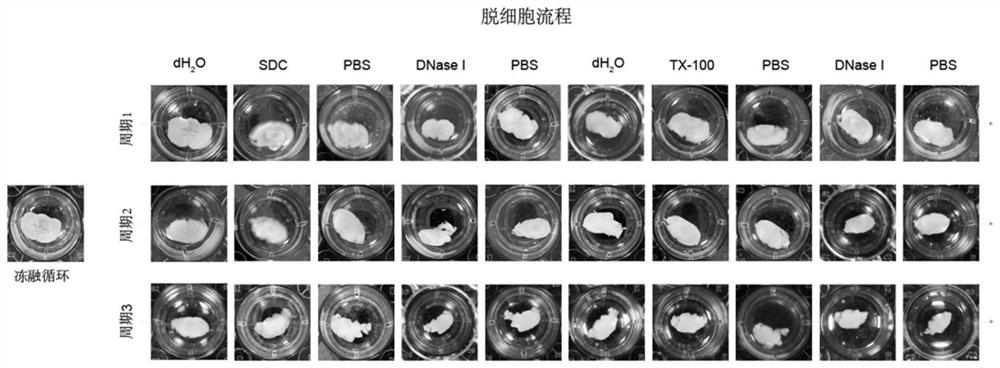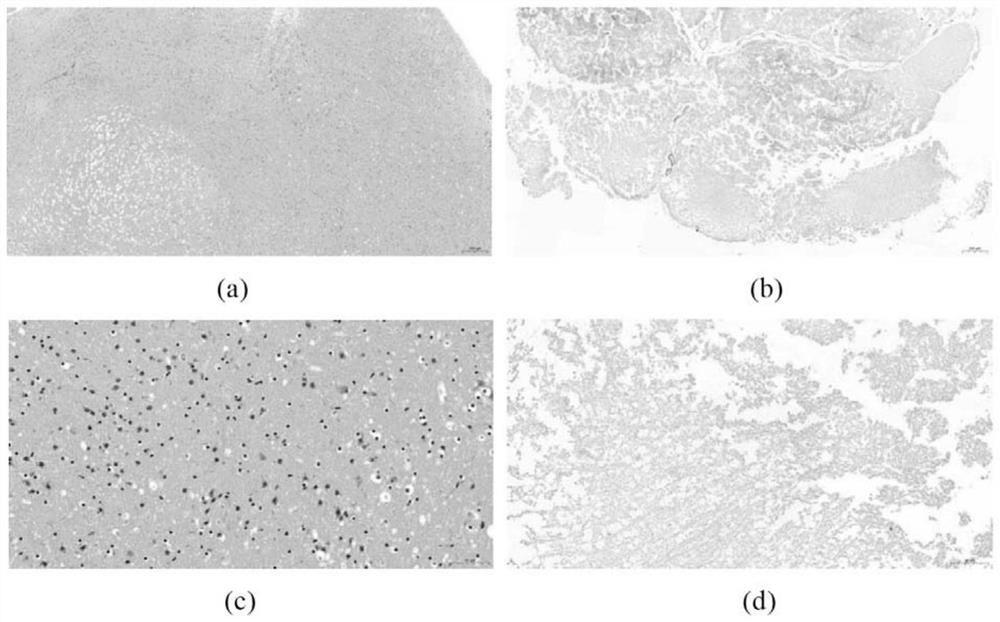Preparation method of brain acellular matrix
A decellularized matrix and decellularized technology, applied in the field of biomaterials, can solve the problems of difficult preparation of acellular matrix, no recognized method, damage, etc.
- Summary
- Abstract
- Description
- Claims
- Application Information
AI Technical Summary
Problems solved by technology
Method used
Image
Examples
Embodiment 1
[0051] Preparation of acellular matrix from C57 mouse brain
[0052] C57BL / 6 mice aged 6-8 weeks were sacrificed by cervical dislocation, soaked in 75v / v% ethanol solution for 2min, and the brain was removed by craniotomy. The extracted brain was removed from the cerebellum and cut into two halves of equal quality along the coronal plane, soaked in PBS solution added with 1% (v / v) double antibody and washed.
[0053] The first step in decellularizing brain tissue is a freeze-thaw cycle. The brain tissue was placed in a 1.5mL EP tube, and was repeatedly frozen and thawed with liquid nitrogen for 3 times: freezing for 10 minutes each time, and then thawing and warming to room temperature for about 20 minutes. Then rinse with PBS solution for 5 to 10 minutes.
[0054] The second step is to transfer the brain tissue to a 24-well plate, and carry out cycle decellularization under the shaking condition of 80 rpm on the shaker, and all the reagents used are added with 1% (v / v) doub...
Embodiment 2
[0057] Evaluation of C57 Mouse Brain Decellularized Matrix
[0058] 1. Histological evaluation
[0059] The decellularized brain obtained in Example 1 (ie, brain decellularized matrix) was evaluated for the effect of removing nuclei. For this, decellularized and non-decellularized brain sections were fixed with 4% paraformaldehyde at room temperature, stained with 4',6-diamidino-2-phenylindole (DAPI), and visualized with a confocal microscope . DAPI staining picture as figure 2 As shown, the results showed that no cell nuclei remained in the decellularized brain tissue.
[0060] In addition, HE staining was used to verify the effect of decellularization, such as image 3 As shown, it shows that the decellularization method of the present invention has good decellularization effect and less nucleus residue.
[0061] Quantitative detection of DNA content in brain decellularized matrix. DNA was purified using DNeasy Blood & Tissue Kit (Qiagen, Hilden, Germany), and then th...
Embodiment 3
[0077] C57BL / 6 mice aged 6-8 weeks were sacrificed by cervical dislocation, soaked in 75% ethanol solution for disinfection for 2 minutes, and the brain was removed by craniotomy. The extracted brain was removed from the cerebellum and cut into two halves of equal quality along the coronal plane, soaked in PBS solution added with 2% (v / v) double antibody and washed.
[0078] To decellularize the brain tissue, the first step is freeze-thaw cycle treatment, which is the same as in Example 1, and three freeze-thaw cycles are performed.
[0079] The second step is to carry out cycle decellularization under the shaking condition of 60 rpm on the shaker, and all the reagents used are added with 2% (v / v) double antibody. First at 25°C with dH 2O was washed for 7 hours, treated with 4w / v% sodium deoxycholate (SDC) for 12 hours, and then washed with PBS solution for 30 minutes; then treated with 40kU / ml DNase I at 37°C for 1h, and then washed with PBS solution at 25°C Wash for 30 min...
PUM
 Login to View More
Login to View More Abstract
Description
Claims
Application Information
 Login to View More
Login to View More - R&D
- Intellectual Property
- Life Sciences
- Materials
- Tech Scout
- Unparalleled Data Quality
- Higher Quality Content
- 60% Fewer Hallucinations
Browse by: Latest US Patents, China's latest patents, Technical Efficacy Thesaurus, Application Domain, Technology Topic, Popular Technical Reports.
© 2025 PatSnap. All rights reserved.Legal|Privacy policy|Modern Slavery Act Transparency Statement|Sitemap|About US| Contact US: help@patsnap.com



